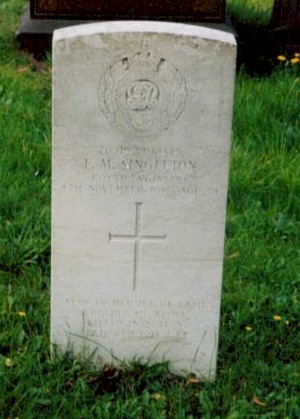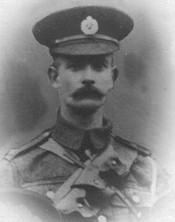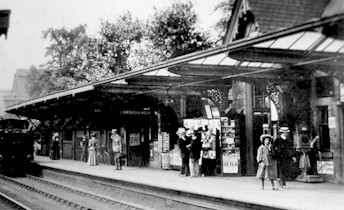|
|
| Home Topics Memorials Miscellany Transcripts References Family History Glossary Latest Beeston Blog About us | Site Search |
|
The "Derby Scheme" was named after Edward George Villiers Stanley, 17th Earl of Derby, in 1915 as Director-General of recruiting, who organised this method of obtaining recruits for the Army on a voluntary basis. Men were invited to attest with an obligation to come if called up but only when the supply of volunteers became insufficient and then according to age and marital status. The failure of the "Derby Scheme" to recruit sufficient numbers of volunteers prompted the introduction of the Government's Compulsory Service Act, which came into force on March 2nd 1916. This measure was first applied to single men between the ages of 18 to 41. The act was finally extended to married men of the same age groups. Edward Marshall Singleton, aged 34, a married man, was therefore called to the 'Colours' in October 1916.
After joining the Royal Engineers he was posted to Aldershot barracks on 1st November where he remained until being sent to France on 16th August 1917. After serving just over two years, most of which was spent on the Western Front, he was allocated his first leave on 18th October 1918. He was spending this well-earned rest with his wife and two young children when he was struck down with a mysterious illness, which resulted in his early death on 4th November. His death, at Berridge Road, Hospital, was almost certainly due to the 'flu epidemic that had come to Britain in May 1918 and was to cause over 228,000 deaths there over the next months.4. Amongst the troops on the Western Front, there had been an early fast-spreading outbreak in the Spring of 1918 (commonly known as "Spanish Flu" - although there was no evidence that it originated in Spain). At first the condition was mild but it became increasingly fatal as the year progressed; inevitably the crowded conditions associated with troop movements added to the dangers of contagion and it may well be that Edward caught the disease as he travelled home. It was a particularly cruel blow to the family. Driver Singleton is buried in Nottingham General Cemetery, Canning Circus, Nottingham. Margaret Singleton visited her father's grave before she died herself, being taken there by the priest of the Catholic church on Foster Avenue, Beeston. Driver Singleton kept a daily diary. Extracts, highlighting his various travels in France and Belgium, from his arrival at the Port of Havre in France, until his untimely death in November 1918 are given here. As the original was written in pencil, the entries have been transcribed so that they can be read clearly.
Footnotes 1Edward's father, Herbert Singleton was born in Chesterfield about 1852; his wife, Edward's mother, was born Jane Marshall in Gilderton, Yorkshire in about 1857. Herbert and Jane had nine children, seven of whom survived into adulthood. Herbert worked for the Midland Railway, apparently moving with the job from time to time. Early in their marriage in 1882, Herbert and Jane lived in Chesterfield before moving to Beeston in about 1890. At the time of the 1891 Census, Herbert was decribed as a Railway Inspector and they were living at 29 Mona St Beeston, Notts (Census Piece 2671 Folio 63)but moved, soon afterwards, to Nottingham. At the time of the 1901 census, Herbert was decribed as a Railway Engineer and the family was living at 15 Pinder House Road, Nottingham (Census Piece 3171 Folio 89). By the time of the 1911 census, Herbert and Jane were living with six of their family at 63 Holgate Road, Nottingham. Herbert was then described as a bridge painter and Jane was self employed as a general dealer (Census Piece 20537 RD 430 SD2 ED24 Schedule 366) 2Edward's brothers were Herbert Francis (b. about 1887) and Mark Basil (b. 1894); each of their Service Records survive, although Edward's does not. Herbert worked as a wholesale druggist's packer before enlisting in June 1916. He served in France as a Sapper with the Royal Engineers (10th Light Railway Operating Company) and was demobilised in January 1919. He was married to Mabel (née Smith); at the time of Herbert's enlistment, they had two children, Hilda Mary (who died in January 1918) and Frederick Arthur and it appears that further children were born after the war. Mark Basil was born in 1894 and worked as a warp hand; he enlisted in September 1914 and went to France in July 1915 with the 13th Battalian, Kings Royal Rifle Corps and became a Lance Corporal. He was killed in action on 5 April 1918 and is buried in Foncquevillers Military Cemetery. 3In 1911 he was described as a Bookstall Clerk. He was then living with his wife and son at 12 Phyllis Grove, Long Eaton.(Census Piece 20827 RD 434 SD4 ED6 Schedule 197) 4The pandemic lasted from March 1918 to June 1920, killed over 50 million people worldwide (3% of the then population). |
|
||||||||||||||||||||||||||||||||||||||||||||||||||||||||||||||||||||||||||||||||||||||||||||||||||||||||||||||||||||||||||||||||||||||||||||||||||||||||||||||||||||||||||||||||||||||||||||||||||||||||||||||||||||||||||||||||||||||||||||||||||||||||||||||||||||||||||||||||||||||||||||||||||||||||||||||||||||||||||||||||||||||||||||||||||||||||||||||||||||||||||||||||||||||||||||||||||||||||||||||||||||||||||||||||||||||||||||||||||||||||||||||||||||||||||||||||||||||||||||||||||||||||||||||||||||||||||||||||||||||||||||||||||||||||||||||||||||||||||||||||||||||||||||||||||||||||||||||||||
|
|
||||||||||||||||||||||||||||||||||||||||||||||||||||||||||||||||||||||||||||||||||||||||||||||||||||||||||||||||||||||||||||||||||||||||||||||||||||||||||||||||||||||||||||||||||||||||||||||||||||||||||||||||||||||||||||||||||||||||||||||||||||||||||||||||||||||||||||||||||||||||||||||||||||||||||||||||||||||||||||||||||||||||||||||||||||||||||||||||||||||||||||||||||||||||||||||||||||||||||||||||||||||||||||||||||||||||||||||||||||||||||||||||||||||||||||||||||||||||||||||||||||||||||||||||||||||||||||||||||||||||||||||||||||||||||||||||||||||||||||||||||||||||||||||||||||||||||||||||||||

 Owing to the terrible loss of lives in the battles of 1914-1915 and the drying up of voluntary enlistment, conscription of men for military service finally
became a necessity in 1916.
Owing to the terrible loss of lives in the battles of 1914-1915 and the drying up of voluntary enlistment, conscription of men for military service finally
became a necessity in 1916. Driver Singleton, who was born in Chesterfield, Derbyshire in 1884, lived with his wife Mabel (née Neal) and two children, Vincent (b. 1909, known as "Vinnie") and Margaret (b. 1917),
at 65 (now 69) Victory Road, Beeston, Notts. He was one of three sons of Herbert and Jane (née Marshall) Singleton of, 63 Holgate Road, Nottingham1; the
three brothers all served in the Great War2. Prior to enlisting in the army, he held the position of Manager for W.H. Smith & Sons, working at the
Beeston & Midland Station Nottingham bookstalls, having joined the company as a school-leaver and gaining steady promotion.3 The photograph, right,
shows the bookstall on Beeston Station, probably taken in Edward's time there.
Driver Singleton, who was born in Chesterfield, Derbyshire in 1884, lived with his wife Mabel (née Neal) and two children, Vincent (b. 1909, known as "Vinnie") and Margaret (b. 1917),
at 65 (now 69) Victory Road, Beeston, Notts. He was one of three sons of Herbert and Jane (née Marshall) Singleton of, 63 Holgate Road, Nottingham1; the
three brothers all served in the Great War2. Prior to enlisting in the army, he held the position of Manager for W.H. Smith & Sons, working at the
Beeston & Midland Station Nottingham bookstalls, having joined the company as a school-leaver and gaining steady promotion.3 The photograph, right,
shows the bookstall on Beeston Station, probably taken in Edward's time there.